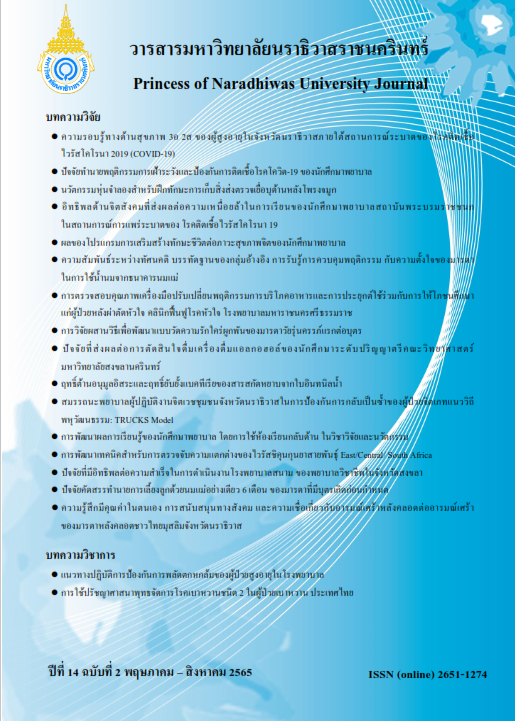The Selected Predicting Factors of Exclusive Breastfeeding Within a 6-month Period among Mothers with Preterm Infants
Keywords:
Exclusive breastfeeding, Mothers with preterm infants, Breastfeeding knowledge, Breastfeeding self-efficacyAbstract
This predictive correlation research aimed to identify the predisposing, enabling and reinforcing factors of exclusive breastfeeding for 6 months, and the predicting factors for a 6-month period of exclusive breastfeeding among mothers with preterm infants. Purposive sampling was used to recruit 210 mothers who brought their preterm infants to the high-risk premature infant clinic at Maharaj Nakhon Si Thammarat Hospital. Data were collected using eight questionnaires. The reliability of the breastfeeding knowledge questionnaire was tested using Kuder’ Richardson method (KR 20), yielding a value .75, and the breastfeeding attitude questionnaire, the barriers on breastfeeding questionnaire, the perceived self-efficacy on breastfeeding questionnaire, the enabling factors access to public health services questionnaire and the reinforcing factors of social on breastfeeding questionnaire were tested using Cronbach’s alpha coefficient, yielding values .82, .97, .85, .93, and .87, respectively. Data were analyzed using descriptive statistics, Chi-square test and multiple logistic regression.
The results revealed that: 1) breastfeeding knowledge, barriers on breastfeeding, and breastfeeding self-efficacy were related to exclusive breastfeeding within a 6-months’ period among mothers with preterm infants (p < .05), and 2) the predicting factors related to the exclusive breastfeeding within a 6-months’ period among mothers with preterm infants were breastfeeding knowledge (adj. OR = 2.27, 95%CI = 1.105-4.669), and breastfeeding self-efficacy (adj. OR = 3.96, 95%CI = 2.069-7.563). Therefore, arranging activities focused on educating breastfeeding knowledge and breastfeeding self-efficacy will help promote exclusive breastfeeding within a 6-month period among mothers with preterm infants.
References
Chaiophanon, S. (2016). Factors affecting 6-month exclusive breastfeeding in Nonthaburi Province. Journal of the Association of Preventive Medicine of Thailand, 6(2), 98-108.
Chupraphan, P. (2014). Factors influencing 6-month exclusive breastfeeding of mothers in the lower central region (Master of science program, public health nursing) Faculty of Public Health, Mahidol University, Bangkok. (in Thai).
Forecast Statistics Division National Statistical Office. (2020). Report on the situation of children and women in Thailand. Retrieved from http:// nso.go.th/sites/2014/DocLib13/Social/Population /Children and Women Situation/2019/1.MICS6_keyindicator_June_62.pdf
Green, L.W., & Kreuter, M.W. (2005). Health program planning and educational and Ecologicalapproach. (4th ed.). New Yok: McGraw-Hill.
Janjindamai, W. (2020). HOT TOPICS IN NEONATOLOGY 2019. In Punnahitanon, S. (Eds.), Smart Practice in Neonatal Care (pages 90-131). Bangkok: Active Print. (in Thai).
Kala, S. (2018). Breastfeeding Support: Nurses’ Role. Songkhla: Chanmeungkanpim. (in Thai).
Kosarat, S. (2020). Maternal Diseases Affecting Newborn Infants. In Punnahitanon, S. (Eds.), Smart Practice in Neonatal Care (pages 1-40). Bangkok: Active Print. (in Thai).
Ministry of Health Public Health Administration Division. (2020). Service Plan report mother and child branch. Retrieved from http://dashboard.anamai.moph.go.th./dashboard
Ngamkan, W. (2020). Development of breastfeeding in preterm infants in Prapokklao Hospital. In Punnahitanon, S. (Eds.), Smart Practice in Neonatal Care (pages 258-270). Bangkok: Active Print. (in Thai).
Office of the National Economic and Social Development Council. (2016). The Twelfth National Economic and Social Development Plan (2017-2021). Prime Minister’s Office Retrieved from http://www.ratchakitcha.soc.go.th/DATA/PDF/2559/A/115/1.PDF
Pomjumpa, S. (2009). Effects of a perceived self-efficacy promoting program on breastfeeding behavior among adolescent mothers. (Master of Nursing Science, Department of Family Nurse Practitioner) Faculty of Nursing, Thammasat University, Bangkok. (in Thai).
Underwood, M. A. (2013). Human milk for the premature infant. Pediatric Clinics of North America, 60(1), 189-207.
Vanichbuncha, K. (2018). Advanced Statistical Analysis with SPSS for Windows. Bangkok: Samlada. (in Thai).
Varolarn, V. (2020). Early Recognition & Prevention of Neonatal Morbidities: ROP. In Punnahitanon, S. (Eds.), Smart Practice in Neonatal Care (pages 218-232). Bangkok: Active Print. (in Thai).
World Health Organization. (2018). Preterm birth. Retrieved from http://www.who.int/news- room/fact-sheeths/detail/preterm-birth
Additional Files
Published
How to Cite
Issue
Section
License
Copyright (c) 2022 Princess of Naradhiwas University Journal

This work is licensed under a Creative Commons Attribution-NonCommercial-NoDerivatives 4.0 International License.




